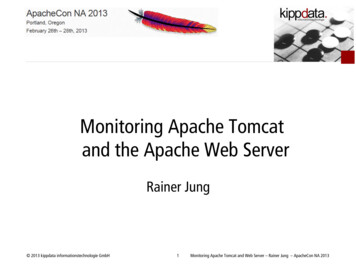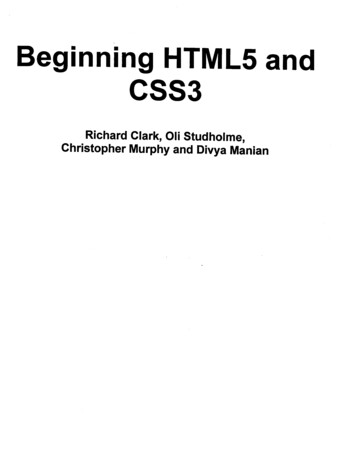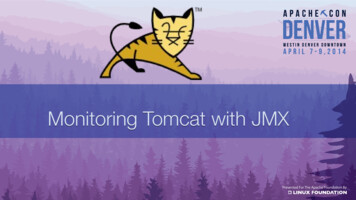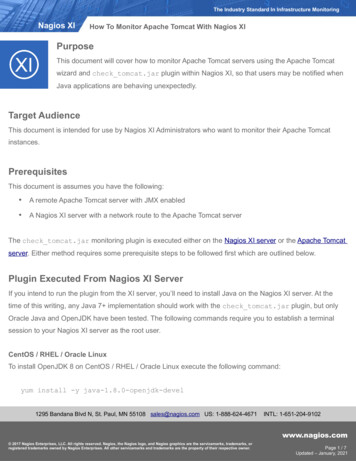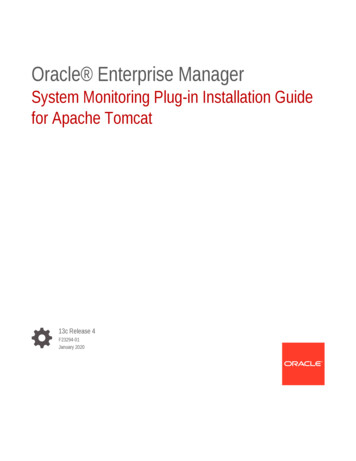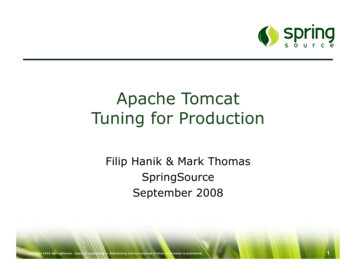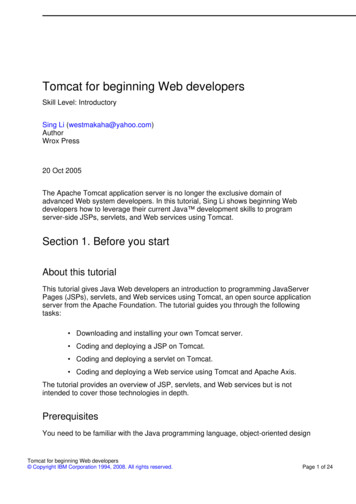
Transcription
Tomcat for beginning Web developersSkill Level: IntroductorySing Li (westmakaha@yahoo.com)AuthorWrox Press20 Oct 2005The Apache Tomcat application server is no longer the exclusive domain ofadvanced Web system developers. In this tutorial, Sing Li shows beginning Webdevelopers how to leverage their current Java development skills to programserver-side JSPs, servlets, and Web services using Tomcat.Section 1. Before you startAbout this tutorialThis tutorial gives Java Web developers an introduction to programming JavaServerPages (JSPs), servlets, and Web services using Tomcat, an open source applicationserver from the Apache Foundation. The tutorial guides you through the followingtasks: Downloading and installing your own Tomcat server. Coding and deploying a JSP on Tomcat. Coding and deploying a servlet on Tomcat. Coding and deploying a Web service using Tomcat and Apache Axis.The tutorial provides an overview of JSP, servlets, and Web services but is notintended to cover those technologies in depth.PrerequisitesYou need to be familiar with the Java programming language, object-oriented designTomcat for beginning Web developers Copyright IBM Corporation 1994, 2008. All rights reserved.Page 1 of 24
developerWorks ibm.com/developerWorksprinciples, and basic TCP/IP networking concepts to get the maximum benefit fromthis tutorial. An understanding of the networking APIs in the JDK is ideal, althoughnot mandatory.To run the examples in this tutorial, you need: A working installation of JDK 1.5.0 or later. A running installation of Tomcat 5.5 or later, available athttp://jakarta.apache.org/tomcat/. This tutorial includes detailed download,installation, and setup instructions for Tomcat.To run the Web services example, you also need to install: Apache Ant 1.5.2 or later, available at http://ant.apache.org/ Apache Axis 1.2.1 or later, available at http://ws.apache.org/axis/. Thistutorial includes detailed installation instructions for Axis.The recommended system configuration for running the tutorial: A system supporting JDK 1.5.0 with at least 512MB of memory. Theinstructions in the tutorial are based on a system running MicrosoftWindows. At least 50MB of disk space to install the software and examples.Section 2. What is Tomcat?Tomcat is an open source server from the Apache Software Foundation. It is a Webapplication server, which means that it comes ready to support programming usingJavaServer Pages (JSPs) and servlets.Since early 2000, Tomcat has served as the reference implementation for the latestJava Servlet and JSP specifications. Tomcat 5.5, the latest Tomcat version as of thiswriting, supports the latest Java Servlet 2.4 and JavaServer Pages 2.0 standards(see Resources). Tomcat also includes a limited Web server that can serve staticWeb pages when executed in stand-alone mode (by default).Because of a variety of open source libraries and extensions, Tomcat supports: Web services using the Apache Axis servlet Development frameworks, such as Apache Struts Templating engines, such as Apache Jakarta VelocityTomcat for beginning Web developersPage 2 of 24 Copyright IBM Corporation 1994, 2008. All rights reserved.
ibm.com/developerWorksdeveloperWorks Object-relational mapping technology, such as HibernateThis tutorial shows you how to use Tomcat to learn JSP, servlet, and Web servicesprogramming. Use of Struts, Velocity, and Hibernate with Tomcat is beyond thistutorial's scope.In the past, because a high level of expertise was required to configure andadminister Tomcat, the primary Tomcat users were advanced server-side applicationdevelopers. Now -- thanks to the maturing of Tomcat's GUI installer, the ability toinstall the server as a system service, and stabilization of the server's features -even beginning Web developers can take advantage of this versatile server.Section 3. Tomcat installation and setupDownloading TomcatTo download the latest version of Tomcat, go to the Apache Tomcat home page(see Prerequisites), shown in Figure 1, and click the Tomcat 5.x link under theDownload heading (the area outlined in red in Figure 1):Figure 1. Apache Tomcat project home pageTomcat for beginning Web developers Copyright IBM Corporation 1994, 2008. All rights reserved.Page 3 of 24
developerWorks ibm.com/developerWorksPage 3 of 11 Document options Print this page PDF - A4 475 KB PDF - Letter 479KB Get Adobe Reader Sample code Rate this tutorial Help us improve thiscontent Tomcat installation and setup Downloading Tomcat To download the latestversion of Tomcat, go to the Apache Tomcat home page (see Prerequisites), shownin Figure 1, and click the Tomcat 5.x link under the Download heading (the areaoutlined in red in Figure 1): Figure 1. Apache Tomcat project home page You have achoice among the latest 5.5.x releases. Choose the binary distribution of the lateststable (nonbeta and nonalpha) release. For Windows systems, download the EXEbinary for simple installation.Installing TomcatThe EXE binary installer does the following: Unpacks and installs the Tomcat server components. Lets you specify the TCP port that the server will use when listening forincoming requests. (A TCP port is a networking endpoint, represented byTomcat for beginning Web developersPage 4 of 24 Copyright IBM Corporation 1994, 2008. All rights reserved.
ibm.com/developerWorksdeveloperWorks a number, that a client application can specify when connecting to theserver.) Configures the server to run as a system service.Start the installation EXE. You'll see the initial splash screen, shown in Figure 2:Figure 2. Tomcat setup wizard splash screenThe installation EXE runs a wizard-based installer with step-by-step instructions.You must have administrator privileges on the machine, because Tomcat is installedas a system service. If you are on your own PC as the default user and haveinstalled other software successfully, you probably already have administratorprivileges.Table 1 describes the items that each screen of the setup wizard prompts for, alongwith the responses you should make.Table 1. Tomcat setup wizard promptsSetup wizard screenDescriptionLicense agreementThis is the Apache License 2.0, one of the moreliberal open source software licenses inexistence. Read the license terms carefully. Ifyou agree to the terms, click the I Agree buttonto proceed.Tomcat for beginning Web developers Copyright IBM Corporation 1994, 2008. All rights reserved.Page 5 of 24
developerWorks ibm.com/developerWorksChoose componentsSelect the components of Tomcat to install. Bydefault, the mandatory components are checked.If you have enough disk space, considerinstalling the examples. They are great forlearning Web application programming.Choose install locationSelect the directory on your computer where theTomcat server will install. If this is your firstinstallation, the default that the wizard selectsshould be fine. This screen also shows howmuch disk space the Tomcat installation will takeup and the amount of free space you have on thedisk.ConfigurationThis screen lets you performs basic Tomcatserver configuration. You can select the TCP portthat the server listens on, as well as anadministrator username and password. It isrecommended that you leave the TCP port at8080. Leave the administrator username asadmin and enter your own administratorpassword. Do not forget the password; you'llneed it later to deploy the examples in thistutorial.Java Virtual MachineThis screen lets you select the JVM that Tomcatruns under. Unless you have multiple JDKsinstalled on your machine, you can use thedefault. For the latest Tomcat 5.5 release, youshould select JVM version 1.5.0 or later.Completing the Apache Tomcat Setup Wizard This is the final step of the installation. Select theRun Apache Tomcat checkbox. This starts thesystem service immediately after installation.Note that on some versions of Windows with a firewall, you might need to giveTomcat explicit permission to listen to the TCP port for requests.After installation, the Tomcat server will be running, with the Apache service-monitoricon appearing in the lower right-hand corner of your Windows Taskbar (the long baron the bottom of the screen), as shown in Figure 3:Figure 3. Service monitor showing Tomcat runningIn Figure 3, the green arrow on the monitor icon indicates that the Tomcat service isrunning.Verifying server operationsIt's simple to access the running Tomcat server and verify that the installation wassuccessful. Start a browser and point it to the address http://localhost:8080/.Tomcat for beginning Web developersPage 6 of 24 Copyright IBM Corporation 1994, 2008. All rights reserved.
ibm.com/developerWorksdeveloperWorks The Tomcat server is listening at port 8080. (You configured this during theinstallation.) Figure 4 shows the welcome screen that Tomcat displays:Figure 4. Tomcat's welcome screenBy running the Tomcat server on the same machine as your browser, you aresimulating a networked environment. Figure 5 shows this loop-back networkconfiguration:Figure 5. Loop-back configuration for single-machine server-side developmentTomcat for beginning Web developers Copyright IBM Corporation 1994, 2008. All rights reserved.Page 7 of 24
developerWorks ibm.com/developerWorksIn Figure 5, both the client (browser) and the server (Tomcat) are running on thesame machine. The TCP connection between the client and the server is running ina loop-back mode. This is a common practice in Web development, enabling you toperform server-side development using a single machine. In actual production, youcan change the host name of the URL from localhost to the IP address of yournetworked production Tomcat server (shown within dashed lines in Figure 5).Section 4. Your first JSP application on TomcatBrief introduction to JSP programmingJSP is a popular scripting and templating language for creating the presentationlayer of server-side Java applications. Typically, JSP is used for pages with adynamic user interface. It can generate HTML, XML, Cascading Style Sheets (CSS),JavaScript, and virtually any client-side presentation content dynamically. The latestwidely implemented JSP version is 2.0, based on Java Specification Request (JSR)152 (see Resources).Essential elements of the JSP language are: DirectivesTomcat for beginning Web developersPage 8 of 24 Copyright IBM Corporation 1994, 2008. All rights reserved.
ibm.com/developerWorksdeveloperWorks Standard actions Expression Language (EL) Custom tag libraries JavaBeansJSP has built-in capability to access JavaBeans. In production applications,JavaBeans are typically used to carry data values between the application logic(implemented using servlets and other components) and JSP. The JSP code'stypical responsibility is to display the value contained in the JavaBean.One of the more frequently used tag libraries for JSP is the JSP Standard TagLibrary (JSTL). JSTL, defined in JSR 52 (see Resources), contains a large library oftags that can be used in conjunction with the EL in JSP. The latest version of JSTL(as of October 2005) is 1.1.Unlike Java programs, JSP programs need not be precompiled. Tomcat compiles aJSP the first time it is executed and keeps a copy of the compiled binary forsubsequent execution. This allows for rapid development and testing cycles.With early versions of JSP (before 2.0), it was difficult to write general applicationlogic without resorting to embedded Java coding. In fact, JSP versions prior to 2.0allowed and encouraged the use of mixed Java/JSP coding. This practice generallycreates code that is messy and difficult to maintain.Beginning with JSP 2.0, with its support for EL and JSTL, embedding Java code inJSP programs is no longer necessary. It is recommended that all new JSPdevelopers not intermix embedded Java code with JSP. This approach is oftencalled scriptless JSP.There's a lot more you can learn about JSP programming after you finish this tutorial(see Resources for more information on JSP). The rest of this section shows youhow to create and run JSP applications using Tomcat, so you can start trying outyour own JSP programming right away.A simple JSP programThe example JSP program in this tutorial illustrates JSP's dynamic HTML-generationcapabilities. The program prints out a message containing the current server-sidetime and a multiplication table. The date information changes every time you accessthe page. The multiplication table is generated using a programming algorithm.You can find the example JSP program, called index.jsp, in the step1 subdirectory ofthe code distribution (see Download). Listing 1 shows index.jsp:Listing 1. Sample JSP Program: index.jsp %@ taglib prefix "c" uri "http://java.sun.com/jsp/jstl/core"% Tomcat for beginning Web developers Copyright IBM Corporation 1994, 2008. All rights reserved.Page 9 of 24
developerWorks ibm.com/developerWorks %@ taglib prefix "fmt" uri "http://java.sun.com/jsp/jstl/fmt"% jsp:useBean id "timeNow" class "java.util.Date" / html head title developerWorks Tomcat Tutorial /title link rel stylesheet type "text/css" href "specials.css" /head body table width "600" tr td class "mainHead" colspan "9" h1 Today is fmt:formatDate value " {timeNow}"type "date" dateStyle "long" / /h1 /td /tr tr c:forEach var "i" begin "1" end "9" step "1" th {i}x /th /c:forEach /tr c:forEach var "row" begin "1" end "9" step "1" tr c:forEach var "col" begin "1" end "9" step "1" td c:out value " {row * col}" / /td /c:forEach /tr /c:forEach /table /body /html Some JSP techniques to note in this program include: The %@taglib directive, used to include the core and formattingcomponents of JSTL, and associating their tags with the namespaceprefix of c: and fmt: respectively. The jsp:useBean standard action to instantiate an instance of thejava.util.Date class as a JavaBean, representing the current time. Use of EL in the {timeNow} expression, representing the JavaBeaninstance of java.util.Date, to print the current month and day. Use of the date-formatting library tag in JSTL to format the date value. Use of the c:forEach tag from JSTL to create the loop that prints outthe multiplication table. The mix of static HTML content with JSP-generated dynamic content.Preparing to run a JSP application on TomcatYou need to complete some packaging work before you can run the index.jspprogram on Tomcat. In general, you need to follow these steps:1.Create your JSP application. If you are working with only one page, call itindex.jsp, as you've done for the example program.Tomcat for beginning Web developersPage 10 of 24 Copyright IBM Corporation 1994, 2008. All rights reserved.
ibm.com/developerWorksdeveloperWorks 2.Create a deployment descriptor -- a web.xml file -- and place it in theWEB-INF directory.3.Copy the JSTL libraries to the WEB-INF/lib directory.4.Bundle all the code, using the JAR tool from the JDK, into a Webapplication archive (WAR) file for deployment.5.Use the Tomcat Web Application Manager to deploy and run the WARfile.The WAR file is a standard Java Enterprise Edition (Java EE) deployment unit. It is aJAR file in a very specific format, with a .war filename extension. In this WAR file,you must have a deployment descriptor file called web.xml, which containsinstructions telling the server how to deploy the content of the WAR.n the case of the example program, the web.xml file (see Listing 2) is trivial, becausethe application contains only one JSP page:Listing 2. The web.xml deployment descriptor ?xml version "1.0" encoding "ISO-8859-1"? web-app xmlns "http://java.sun.com/xml/ns/j2ee"xmlns:xsi emaLocation m/xml/ns/j2ee/web-app 2 4.xsd"version "2.4" description developerWorks Beginning Tomcat Tutorial /description display-name IBM developerWorks Beginning Tomcat Tutorial /display-name /web-app The web.xml file in Listing 2 simply provides a description and display name toTomcat, which will be used later by the Tomcat Application Manager.To create the WAR file, run the makewar.bat batch file in the code distribution (seeDownload). This batch file simply calls the JAR utility to create a JAR file. Listing 3shows the contents of makewar.bat:Listing 3. makewar.batjar cvf step1.war .In you're on a Linux system, you can enter jar cvf step1.war . at the consoleto create the WAR file manually.Deploying an application with Tomcat Web ApplicationTomcat for beginning Web developers Copyright IBM Corporation 1994, 2008. All rights reserved.Page 11 of 24
developerWorks ibm.com/developerWorksManagerTo run the application on Tomcat, you need to deploy the WAR file first. Use theTomcat Web Application Manager (Manager for short) utility for this. You can accessManager by pointing your browser to http://localhost:8080/manager/html.Tomcat will ask you for a username and password. Enter the administrator username and password that you supplied during setup. Once you have logged in to theserver, you will see the Manager's display. It shows all the applications that arecurrently loaded and running on the Tomcat server, as shown in Figure 6:Figure 6. The Tomcat Web Application Manager utilityTo deploy step1.war, scroll down to the bottom of the Manager page. Click theBrowse button next to the WAR file to deploy section. Use the browser to selectthe step1.war file, then click the Deploy button. This action sends the WAR file to theTomcat server and starts it.You should now see the step1.war application running on Manager's list of runningTomcat for beginning Web developersPage 12 of 24 Copyright IBM Corporation 1994, 2008. All rights reserved.
ibm.com/developerWorksdeveloperWorks applications. Note also that this list uses the display name you set in web.xml toidentify the application.Finally, you can see the JSP application running by pointing a browser tohttp://localhost:8080/step1/.By default, Tomcat uses the name of the WAR file to provide a context for theapplication. The context is specified as part of the address you used to access theapplication. In this case, the context is step1. Tomcat looks for a file called index.jspin the application's root directory to execute if it exists. Figure 7 shows the runningJSP application:Figure 7. A running JSP application on TomcatIf you make any modifications to the JSP code (as you learn JSP), you can performthe following steps to run the new code:1.Use makewar to create a new WAR file.2.Click undeploy in Manager to undeploy the old step1.WAR.3.Use Manager to deploy the new WAR file.Tomcat for beginning Web developers Copyright IBM Corporation 1994, 2008. All rights reserved.Page 13 of 24
developerWorks ibm.com/developerWorksSection 5. Breaking into servlets development withTomcatBrief introduction to servletsServlets are server-side Java code that is executed under the control of a servletcontainer, such as the Tomcat server. Servlets, like JSPs, accept incoming requests,perform processing or transformation, and then generate outgoing responses.Because servlets are actual Java code, you have the power and flexibility of theJava programming language at your disposal to create server-side logic.All servlets implement the javax.servlet.Servlet interface, either directly orindirectly through a helper class that implements the interface. Servlets can also usethe APIs provided by the container, exposing container services. For example, aservlet can obtain a database connection from the container to access a relationaldatabase.Servlets are typically used to implement Web application logic. Servlets can fetchand process data, and then pass the data to a JSP for presentation (for example,dynamic generation of the user interface). Servlets are also used frequently toprocess data submitted through a Web-based form.Tomcat 5.5 implements Servlet 2.4, the latest finalized servlet standard specified inJSR 154 (see Resources).This section shows how to use Tomcat for learning servlets programming. SeeResources for more information on servlets.Servlet example to generate menu specialsThe example in this section displays today's special menu items for a fictitiousrestaurant. A servlet is responsible for fetching the data, and a JSP is responsible fordynamically generating the HTML to display the specials. The JSP in this example iscalled showspecials.jsp, and the servlet is in thecom.ibm.dw.tutorial.tomcat.SpecialsServlet Java class.This example illustrates a typical pattern in Web applications:1.A servlet accepts an incoming request from the user.2.The servlet performs processing, based on the incoming request.3.The servlet dispatches the request, with data attached as attributes, to aJSP.Tomcat for beginning Web developersPage 14 of 24 Copyright IBM Corporation 1994, 2008. All rights reserved.
ibm.com/developerWorks4.developerWorks The JSP generates a dynamic response to present the data.Listing 4 shows the code for SpecialsServlet:Listing 4. The SpecialsServlet servletimportimportimportimportpackage ic class SpecialsServlet extends HttpServlet {protected void doGet(HttpServletRequest request,HttpServletResponse response)throws ServletException, IOException {ServletContext context ", specials.jsp").forward(request, response);}protected void doPost(HttpServletRequest request,HttpServletResponse response)throws ServletException, IOException {doGet(request, response);}private List getSpecials() {List retval new Vector();retval.add(new Special("Coq au Vin", 15));retval.add(new Special("Pad Thai", 10));retval.add(new Special("Lobster Thermador", 10));retval.add(new Special("Baked Alaska", 8));return retval;}public class Special {int price;String menuItem;public Special(String item, int inPrice) {menuItem item;price inPrice;}public int getPrice() {return price;}public String getMenuItem() {return menuItem;}}}The servlet code in Listing 4:1.Declares an inner class called Special to hold a menu special.2.Creates a list of specials in a method called getSpecials().3.In the doGet() method, which Tomcat calls to handle an incomingHTTP request, attaches the list of specials as an attribute calledspecials to the request.4.Forwards the request to showspecials.jsp for presentation.Tomcat for beginning Web developers Copyright IBM Corporation 1994, 2008. All rights reserved.Page 15 of 24
developerWorks ibm.com/developerWorksJSP to show today's specialListing 5 displays the showspecials.jsp code:Listing 5. The showspecials.jsp code %@ taglib prefix "c" uri "http://java.sun.com/jsp/jstl/core"% %@ taglib prefix "fmt" uri "http://java.sun.com/jsp/jstl/fmt"% jsp:useBean id "timeNow" class "java.util.Date" / %@ page session "true"% html head title developerWorks Tomcat Tutorial /title link rel stylesheet type "text/css" href "specials.css" /head body table width "600" tr td class "mainHead" colspan "2" Today's specials for fmt:formatDate value " {timeNow}" type "date"dateStyle "long" / /td /tr tr th Specialty /th th Price /th /tr c:forEach var "special" items " {specials}" tr td {special.menuItem} /td td \ {special.price} /td /tr /c:forEach /table /body /html You can see that the same techniques used Listing 1 for the step1 example in thepreceding section (Your first JSP application on Tomcat) are used here: The JSTL date formatting tag formats a java.util.Date JavaBeaninstance. The c:forEach JSTL loop tag iterates through the List attribute ofspecials (attached to the request object by SpecialServlet). EL expressions display the value of the specials.Deploying the servlet to TomcatServlets live in a Web application, in the same way as JSPs. You need to packagethe application into a WAR file before deploying both JSPs and servlets to Tomcat.Place the classes for a servlet under the WEB-INF/classes subdirectory for theapplication.The Web descriptor for this example is slightly different from the one in Listing 2 inthe preceding section (Your first JSP application on Tomcat). It must tell TomcatTomcat for beginning Web developersPage 16 of 24 Copyright IBM Corporation 1994, 2008. All rights reserved.
ibm.com/developerWorksdeveloperWorks about the servlet and how to map it to incoming requests. Listing 6 shows theweb.xml file for this example:Listing 6. web.xml file ?xml version "1.0" encoding "ISO-8859-1"? web-app xmlns "http://java.sun.com/xml/ns/j2ee"xmlns:xsi emaLocation m/xml/ns/j2ee/web-app 2 4.xsd"version "2.4" description developerWorks Beginning Tomcat Tutorial /description display-name IBM developerWorks Beginning Tomcat Tutorial Step 2 /display-name servlet servlet-name Specials /servlet-name servlet-class com.ibm.dw.tutorial.tomcat.SpecialsServlet /servlet-class /servlet servlet-mapping servlet-name Specials /servlet-name url-pattern /showspecials.cgi /url-pattern /servlet-mapping /web-app This deployment descriptor includes a servlet element that tells Tomcat aboutthe servlet's implementation class. The servlet-mapping element tells theserver that requests destined for showspecials.cgi should be passed to this servlet.You must compile the servlet before you can create the WAR file. Because servletsare Java code, they must be compiled before they can be deployed. You can usethe compile.bat batch file in the code distribution (see Download) for this purpose.However, you need to modify it to point to your own Tomcat directory, becauseservlet-api.jar from Tomcat's common/lib directory contains some interfaces andhelper classes that are required to compile the servlet.After you've compiled the application successfully, you can make the WAR file byexecuting makewar.bat. The WAR file is called step2.war this time. Once the WARfile is created, you can deploy it using the Tomcat Manager.You can access the Web application by pointing a browser cat now maps the URL path of showspecials.cgi to the servlet code. This wasspecified in web.xml by a servlet-mapping element. Figure 8 shows the outputof the application, displaying the menu specials:Figure 8. SpecialsServlet running on TomcatTomcat for beginning Web developers Copyright IBM Corporation 1994, 2008. All rights reserved.Page 17 of 24
developerWorks ibm.com/developerWorksIf you make changes to the servlet code, you can run the new code with these steps:1.Recompile the code using compile.bat.2.Create the step2.war using makewar.bat.3.Undeploy any old step2.war using Tomcat Manager.4.Deploy the new step2.war.Section 6. Discovering Web services development withTomcatBrief introduction to Web servicesWeb services are server-side code components that can expose their functionalityfor access over a TCP/IP network using the standard HTTP protocol. This exposurelets Web service users, called consumers, consume Web services over mostnetwork connections -- and even through firewalls.A Web service processes incoming requests and generates responses. This isexactly what a servlet does, so it is quite natural to implement Web services usingTomcat for beginning Web developersPage 18 of 24 Copyright IBM Corporation 1994, 2008. All rights reserved.
ibm.com/developerWorksdeveloperWorks servlets.Web services are becoming increasingly popular because they can be effectivelyused for business-to-business or business-to-consumer interfaces. They let requestsbe sent, and responses received, through the Internet. Any user who can accessyour Web site can also access your Web service(s). For example, both eBay andAmazon.com offer Web services that their partners and users can consume.Web services depend on passing XML-based messages between the consumer andthe service. The messages are packaged and sent according to the Simple ObjectAccess Protocol (SOAP).Apache Axis is a Web services development kit that can be used as an add-on toTomcat. The next section shows you how to create a simple Web service, usingApache Axis, and deploy it on your Tomcat server. See Resources for articles andtutorials that can help you learn more about Web services programming.Adding Axis to TomcatAxis can run as a servlet on Tomcat. If you haven't already done so, download thelatest version of Axis (see Prerequisites). Unarchive the Axis distribution.Copy all the files under the webapps/axis directory of the Axis distribution to thestep3/axis directory of this article's code distribution (see Download).You can use the makewar.bat batch file, found in the step3/axis directory, to createan axis.war file that can be deployed to Tomcat as a Web application.Before Axis will run properly on Tomcat, you might need to download someadditional JAR files over the Internet and place them into the WEB-INF/lib directoryof the step3 application. If you're using Axis 1.2.1, you need to download thefollowing: activation.jar /jaf.html xmlsec-1.2.1.jar from http://xml.apache.org/security/ mail.jar from http://java.sun.com/products/javamail/If you are not using version 1.2.1 of Axis, the above list might differ slightly. See thedocumentation accompanying the Axis distribution for more information.A simple Web service to publish today's specialsContinuing the restaurant menu-special theme, the Web service you create in thissection's example provides the consumer with a list of menu items on special fortoday.Tomcat for beginning Web developers Copyright IBM Corporation 1994, 2008. All rights reserved.Page 19 of 24
developerWorks ibm.com/developerWorksThe code for the Web service is contained in the ShowSpecials.jws file, shown inListing 7:Listin
Java Servlet and JSP specifications. Tomcat 5.5, the latest Tomcat version as of this writing, supports the latest Java Servlet 2.4 and JavaServer Pages 2.0 standards (see Resources). Tomcat also includes a limited Web server that can serve static

